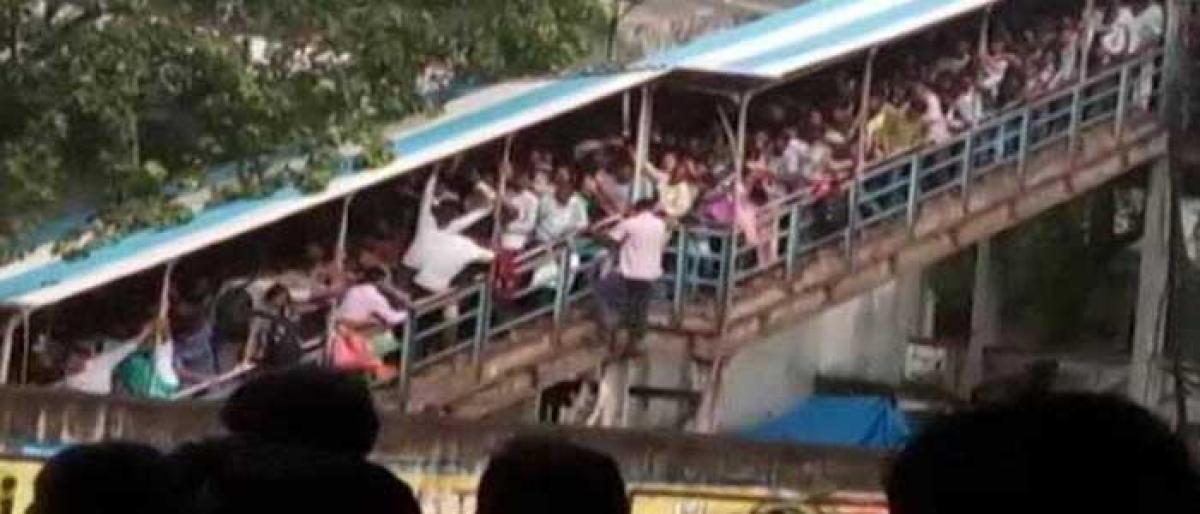Live
- Bengal bypolls: TMC leading in all six seats after 2nd round of counting
- Stimulating NREM sleep can boost cognitive function, memory
- EO releases TTD employees’ cricket team Jersey
- Priyanka Gandhi leads by 90,000 votes in Wayanad, Cong edges out BJP in Palakkad Assembly seat
- US CDC confirms H5N1 bird flu infection in child in California
- Dispose dump yard garbage in 3 months: TTD EO
- Gold rates in Vijayawada today surges, check the rates on 23 November, 2024
- Gold rates in Hyderabad today surges, check the rates on 23 November, 2024
- Punjab bypolls: Counting of votes begins for four Assembly seats
- Kakani lodges complaint against TDP
Just In

Stampede on a narrow railway footover bridge connecting Parel and Elphinstone Road stations of Western Railway on Friday morning resulted in the death of several commuters. A sudden rumour of a suspected electrical short-circuit reportedly triggered a panic run. Officials, however, blamed it on overcrowding on the footover bridge due to torrential rains as people took shelter there. Congregation o
Stampede on a narrow railway footover bridge connecting Parel and Elphinstone Road stations of Western Railway on Friday morning resulted in the death of several commuters. A sudden rumour of a suspected electrical short-circuit reportedly triggered a panic run. Officials, however, blamed it on overcrowding on the footover bridge due to torrential rains as people took shelter there. Congregation of people is always prone to such crowd disasters. It may be due to psychological state of panic that makes the crowd go berserk. But, often such crowd behaviour turns fatal due to breakdown of co-ordination resulting from inept planning.
The history of human civilisation reveals that even the ancient man was conscious of such fatality at a time when population was so sparse. Look at the construction of Colosseum in Rome, which could take up to over 70,000 visitors. It had more than 60 numbered entrances. The exits are located side by side, around the entire circumference of the Colosseum. The Colosseum could be evacuated within just about 5 minutes. The modern man ably aided by technology can certainly plan much more robust constructions to withstand any kind of disturbances.
The crowd-carrying capacity of entry and exit points and the pathway in between should be much wider than the expected influx of people. Effective public address system should be in place to warn the public to avoid panic. All areas, in which high crowd densities may occur or where many people may accumulate, must be analysed for risks. The comprehensive crowd management plan should foresee all possible risks and clearly identify people to manage them. Spread of rumours can trigger mob frenzy. Effective communication through public address system should be put in place to regulate crowds.
There are multiple causal interdependencies for a crowd-related disaster to strike. They include failure of flow controls, a lack of overview of everybody etc.
Elaborate contingency plans should be worked out and executed effectively in case earlier crowd management plans fail. Better communication should exist among all stakeholders at every stage. One should be conscious of early signs of a crowd disaster. Evacuation of people should begin before the area gets overcrowded, thus rendering it difficult to manage. This would at least mitigate the disaster, if not prevent it.
Effective crowd flow management is critical to avert such tragedies. Experts suggest measures like avoidance of intersecting flows separating different flow directions, considering alternative routes for crowds to flow, reserving space for emergency movement of personnel and vehicles, removing bottlenecks in the organisation and obstacles in the seamless flow of crowds, etc. Crowd disasters occur due to interplay of multiple factors. There is voluminous literature to tell us how to avert such a tragedy. But, the Railway authorities seem to have failed in designing effective crowd management strategies.
The problem is not lack of resources or capability, but the lack of will. Crowd management strategies should be part of an overall disaster management efforts as railway stations often witness mass congregation of people. A crowd disaster is a man-made one which can be completely prevented with proactive planning and flawless execution.

© 2024 Hyderabad Media House Limited/The Hans India. All rights reserved. Powered by hocalwire.com







